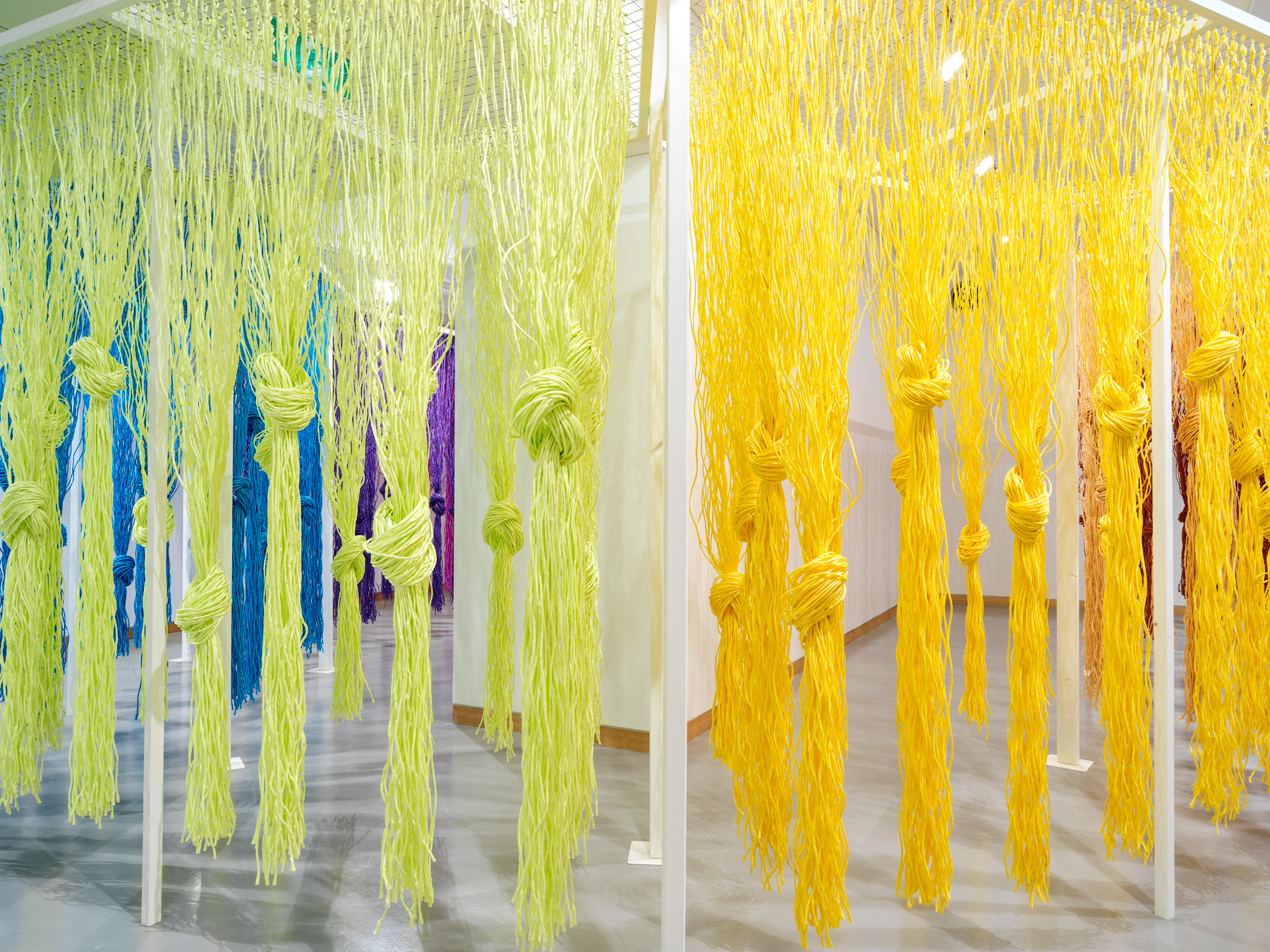Jane Skeer inhabits a work as she makes it. Never on the outside looking in, Skeer is embedded in her work through flashes of autobiographic detail, uncanny intuition and the physical process of assembling material en-masse.
Frequently enthralled by chance encounters with offcuts, surplus, over-production and excess-of, the seemingly mundane, Skeer goes to great lengths sourcing unusual materials for her ever-expanding installations. Once drawn to a particular material Skeer starts obsessively stockpiling, salvaging the unwanted and befriending unlikely allies with her singular focus. This intense period is the unseen labour that imbues Skeer’s work with a sense of storytelling.
Words by Serena Wong, @ Walkway Gallery, Bordertown (complete essay at the end of images)
Twine
2019
Approx 270 x 800 x 800cm
Oversupply of polypropylene bailing twine, steel, timber
Photographer Grant Hancock
words by SERENA WONG accompanying exhibition @ Walkway Gallery, Bordertown, SA
Jane Skeer inhabits a work as she makes it. Never on the outside looking in, Skeer is embedded in her work through flashes of autobiographic detail, uncanny intuition and the physical process of assembling material en masse.
Frequently enthralled by chance encounters with offcuts, surplus, over-production and excess-of, the seemingly mundane, Skeer goes to great lengths sourcing unusual materials for her ever-expanding installations. Once drawn to a particular material Skeer starts obsessively stockpiling, salvaging the unwanted and befriending unlikely allies with her singular focus. This intense period is the unseen labour that imbues Skeer’s work with a sense of storytelling.
Materials, and their history, are integral to the work Skeer makes - their stories are her stories. Skeer has used rope, taken from her grandfathers shed and woven it into large, hanging bulbous cones. A memorial to his past as a fisherman, their personal relationship and the act of grieving and reminiscing as embodied in ‘keeping busy’. She has used truck straps reminding her of time spent driving long distances along the Limestone Coast, where forestry is one of the biggest industries, and log trucks used to secure their load with this simple (and sometimes fallible) equipment.
Farmers, never ones to waste what can be re-used, have taken note of Skeer’s work and recently began donating bailing twine to her. Bailing twine was once made from hemp and broke down over time, but now, because it’s easier to spot, it is made out of polypropylene in vast range of colours, accumulating instead of degrading. It has become ubiquitous on any farm, its tell-tale flash of colour used for almost any quick-fix situation (my grandfather always had a length of blue bailing twine handy). Skeer has taken this banal material used for every day mundane tasks, and transformed the gallery, her installation bringing a sense of play and wonder to this basic farmers’ tool.
There is a new reality of farming in Australia that goes beyond the heroic images, like Tom Roberts A breakaway! (1891), where a farmer astride his horse, chases down escaping stock amongst gumtrees and red dirt. Facing extended droughts, frequent heatwaves and the heartache born from increasingly unpredictable conditions, farmers, who manage almost half of Australia’s land and produce over 90% of our daily domestic food supply[1], are at the mercy of the ever-more apparent signs of climate change. Skeer who grew up in the Limestone Coast, is intimately aware of these challenges, and also the hidden, yet incredible communities who rise to face them. Through the use of twine, she is weaving a tale of resilience and courage, alongside the narrative of hardship.
The rainbow, used as a symbol of hope, is also meteorological phenomenon dictated by those same unpredictable resources farmers rely on, precipitation and light. Skeer’s rainbow embodies the delicate balance of nature needed by farmers - a string of good luck, planting at just the right time to capture the arrival of rain you’ve prayed will fall; or a string of bad luck, too little rainfall, a heatwave that speeds evaporation and crushes a crop. Skeer’s tapestry is made of complicated threads, a community of the fortunate and unfortunate, bound together in a nation, a passion, a way of life.
[1] National Farmers Federation, ‘Farm Facts’ from
Food, Fibre & Forestry Facts (2017) publication https://www.nff.org.au/farm-facts.html





















